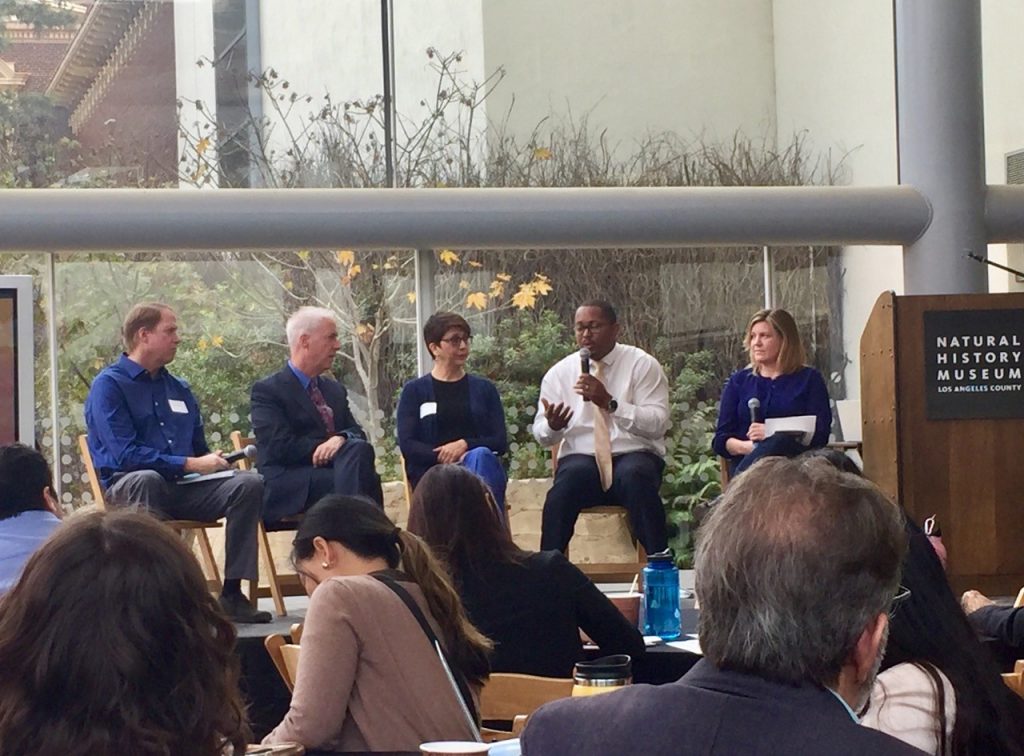On the morning of November 16th, Los Angeles County launched their sustainable planning effort in front of more than 100 community leaders at the Natural History Museum. Supervisor Ridley-Thomas kicked off the morning event in the beautiful glass enclosed space adjacent to the museum’s native Nature Gardens.

The Supervisor emphasized the need for the county to step up and provide sustainability leadership at a time when federal support is dwindling. He brought up critical sustainability challenges such as being good stewards for the environment at a time when we are pressed for more affordable housing. Also, he stated that we need to reduce resource consumption while fostering economic growth. Supervisor Ridley-Thomas also implored the audience to hold the county and the Board of Supervisors accountable for producing a sustainability plan that prioritizes equity, the economy and the environment that serves as an implementation plan to achieve results. Despite the supervisor’s shameless plug for a Trojan victory at the Coliseum on Saturday, I found myself agreeing with his aspirations for the county’s sustainability planning efforts.
The county’s Chief Sustainability Officer Gary Gero was next up on the program. He walked the audience through a history of environmental progress in the county, with a specific focus on air pollution. His narrative of growing up in L.A. and being forced to play indoors during smog-alert days was a history that many of us middle-aged attendees shared. Although we still have some of the worst air quality in the country including two very poor years in a row, conditions have improved dramatically for most Angelenos. Gero stated that he wants the new plan to be a visionary document with both short and long term goals and that plan implementation success will result in equity, good jobs, and healthy, livable places for all. Both Gero and Ridley-Thomas spoke proudly about the County’s ongoing sustainability programs including Community Choice Aggregation, PACE energy efficiency programs, the recent parks measure, the Green Zones Initiative and the water resiliency planning effort.
Later in the morning, there were two panels moderated by environmental reporters Molly Peterson and Emily Guerin. The panelists included sustainability experts, community leaders, health professionals, academics, and even a staff member from the Governor’s Office of Planning and Research. Unlike the dozens of sustainable city planning meetings I’ve participated in the last 25 years, this was the first one that truly put equity on co-equal terms with the environment. Nearly all the panelists emphasized the need for a collaborative planning process that resulted in actionable recommendations that would truly benefit communities. Meeting numeric metrics for a city or the county is not enough if there are some communities within that city that still suffer disproportionate environmental health impacts or affordable housing shortages, lack of access to open space or affordable public transit, or limited opportunities to earn a living wage.
The morning also included a number of breakout sessions to work on broad goal statements for air, water, open space, housing, public health and more. This effort was more successful in engaging the audience than developing strong sustainable plan goals with measurable beneficial outcomes. But by-in-large, the morning was a fitting kickoff for an ambitious planning effort with a number of challenges ahead. How do you develop a sustainable county plan that will improve the quality of life for all 10 million people in L.A. County? The plan needs to have measurable short, medium and long-term goals and objectives with milestones. In order to ensure accountability, there needs to be a self assessment procedure that includes annual reporting and evaluations of department heads (such as the City of L.A.), and quantitative assessment of progress towards goals (such as Santa Monica and Los Angeles). The planning effort needs to include actions that will transform county agencies and facilities to sustainable practices and outcomes, but just as importantly, the effort needs to engage and incentivize the community to participate and help lead in the sustainable county planning and plan implementation efforts. Also, the effort needs to leverage ongoing investments in transportation ($120 billion over 40 years for Measure M), affordable housing, parks and water resiliency to ensure that those infrastructure investments move the county towards a sustainable future.
Like the first day of spring training, everyone is optimistic about what lies ahead in the future. Anticipation is high and community leaders are excited about the prospects of a sustainable L.A. County that provides an improved quality of life for all. For the future to match the aspirations, we need to at least start with a great vision and a great plan. November 16th was a good first step.
Mark Gold, Associate Vice Chancellor for Environment and Sustainability at UCLA
This blog post originally appeared on Medium.
